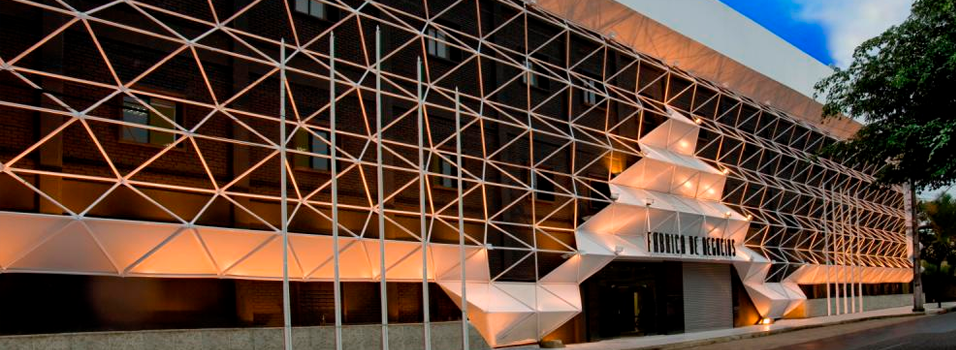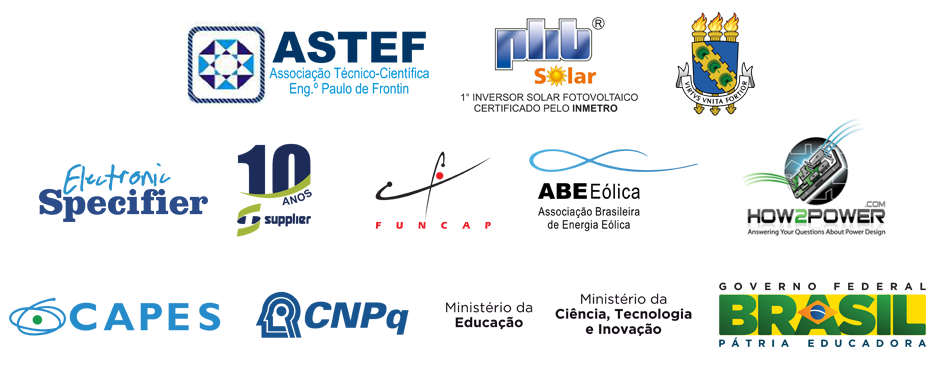Scientific Program
The Brazilian Power Electronics Conference – COBEP is a conference held every odd year in Brazil, since 1991, supported by the Brazilian Power Electronics Society – SOBRAEP. Due to high technical and scientific levels COBEP has long been technically sponsored by the IEEE. For 2015 we are pleased to introduce the first IEEE Southern Power Electronic Conference – SPEC along with COBEP in a unique event of power electronics in the Southern hemisphere.
The conference covers the fields of interest of the power electronics community, providing a forum for sharing theoretical and practical developments related to power electronics, featuring strong participation of industry and academia.
The main topics of the conference include:
- Power converters topologies and design;
- Electrical machines and drive systems;
- Modeling, simulation and control in power electronics;
- Devices, packaging, integration, magnetic materials and passive components;
- Industrial, commercial and residential applications;
- Renewable energy systems;
- Smart grid and utility applications;
- Energy efficiency, power quality and electromagnetic compatibility;
- Education and special topics.
|
SUNDAY 29/11 |
MONDAY 30/11 |
THURSDAY 01/12 |
WEDNESDAY 02/12 |
|
Tutorial 1 and 2 8:00 – 12:00 |
Registration 8:00 – 8:30 |
8:00 – 8:45 Energy Internet and Critical Power Electronics Technology – Alex Q. Huang |
8:00 – 8:45 Power Electronic Converters for Grid Connected and HVDC Applications – Prof Pat Wheeler |
|
8:45 – 9:30 Predictive Control: a New and Powerful Technique for Power Electronics and Drives – Jose Rodriguez |
8:45 – 9:30 The Challenge of Technological Development case study based on the MagLev-Cobra project – Richard M. Stephan |
||
|
Coffee Break 9:30 – 9:50 |
Coffee Break 9:30 – 9:50 |
Coffee Break 9:30 – 9:50 |
|
|
Oral Presentations 9:50 – 11:10 |
Oral Presentations 9:50 – 11:10
|
Oral Presentations 9:50 – 11:10
|
|
|
Posters Session 11:10 – 13:10 |
Posters Session 11:10 – 13:10 |
Posters Session 11:10 – 13:10 |
|
|
Lunch 12:00 – 14:00 |
Lunch 13:10 – 14:00 |
Lunch 13:10 – 14:00 |
Lunch 13:10 – 14:00 |
|
Tutorial 3 and 4 14:00 – 18:00 |
Oral Presentations
14:00 – 15:40 |
Oral Presentations 14:00 – 15:40 |
Oral Presentations 14:00 – 15:40 |
|
Coffee Break 15:40 – 16:00 |
Coffee Break 15:40 – 16:00 |
Coffee Break 15:40 – 16:00 |
|
|
Posters Session 16:00 – 17:30 |
Oral Presentations 16:00 – 18:00 |
Oral Presentations 16:00 – 18:00 |
|
|
RAP SESSION 17:30 – 18:30 |
|||
|
OPENING CERIMONY 19:00 – 20:30 |
SOBRAEP Meeting 18:30 – 20:30 |
||
|
Coquetel 20:30 – 22:00 |
Dinner 20:00 – 24:00 |
PLENARY SESSION 1, 30/11, 08:00-08:50

Power Electronics: A New Beginning By Slobodan Ćuk, TESLAco
Power Electronics progress depends on the progress in its two constituent areas: System Technology and Power Management Technology, which had been traditionally developed in the past in companies specializing in either one or the other area of expertise. System Technology companies, or Power Supply companies relied heavily on the use of the components (switches, drive and control circuits) developed by Power Management companies.
The System Technology popularly known as converter topologies has changed very little in last 50 years and is, in fact, the key reason why the Power Electronics as whole has progressed much less despite the tremendous advances made by Power Management companies in developing the new switching devices with ever increasing switching devices power and speed improvements and high performance digital control circuits.
The conventional topologies are analyzed and the sources of their deficiencies are established. This, in turns, leads to the new switching methods and the corresponding novel switching converter topologies which are overcoming all these deficiencies. However, no incremental change will do, but a fresh new look is needed. Hence what is needed is: Power Electronics: A New Beginning!
Dr. Slobodan Ćuk
Dr. Ćuk received his bachelor degree from Belgrade University, Yugoslavia, 1970, MSEE degree from University of Santa Clara, USA 1974 and her Ph.D. from Caltech, California , USA, 1976.
Dr. Ćuk was the full-time Professor of Electrical Engineering at the California Institute of Technology until January 1, 2000 where he conducted research and taught courses in Power Electronics and Fundamentals of Energy Processing. During his 25 years at Caltech, more than 35 students obtained Ph.D. degree in Power Electronics under his guidance. More than dozen of his former students are Professors of Power Electronics in U.S. and abroad while others are leading researchers in the industry.
For the invention of Integrated Magnetics Dr. Ćuk obtained a 1991 Edward Longstreth Medal from Franklin Institute which was for the first time in its 100 years history awarded to researchers in Power Electronics. His publications include over 100 scientific papers in the Power Electronics field and a three-volume book on Switched-Mode Power Conversion.
Over a span of 20 years, Dr. Ćuk has taught a number of public and in-house courses in United States, Europe and Far East, which were attended by over 4,000 Power Electronics specialists. In 1979, Dr. Ćuk founded TESLAco. He holds over 20 patents in switching power conversion filed. Over dozen patents on Ćuk Optimum Power Conversion technology are pending or are currently in preparation.
Dr. Ćuk’s Inventions and Discoveries
1. Optimum Topology Converter, known as the ĆUKconverter (1974)
2. Coupled-Inductor and Integrated Magnetics method (1975)
3. State-space averaging method (1975)
4. TESLAconverter (2000)
5. Hybrid-switching and Storageless-Switching Method (2009)
PLENARY SESSION 2, 01/12, 08:00-08:45

Energy Internet and Critical Power Electronics Technology
Dr. Huang proposed the revolutionary FREEDM (Future Renewable Electric Energy Delivery and Management) System in 2007 as a novel architecture suitable for plug-and-play of distributed renewable energy and distributed energy storage devices. Motivated by the success of the Information Internet, the architecture was put forward as a transformative platform for an Energy Internet. In the Information Internet, people share information in a plug and play manner. In the envisioned ‘Energy Internet’, a vision for sharing of the energy is proposed for ordinary citizen and home owners. Key enabling technologies required to achieve such a vision will be discussed. Among many of the key technologies, the development of advanced wide bandgap power semiconductor devices and medium voltage power electronics systems will be discussed and highlighted.
Dr. Alex Q. Huang
Dr. Alex Huang received his B.Sc. degree from Zhejiang University, China in 1983 and his M.Sc. degree from Chengdu Institute of Radio Engineering, China in 1986, both in electrical engineering. He received his Ph.D. from Cambridge University, UK in 1992. From 1994 to 2004, he was a founding member and a professor of Center for Power Electronics System (an NSF ERC) at Virginia Tech. Since 2004, he has been a professor of electrical engineering at North Carolina State University and he is currently the Progress Energy Distinguished Professor of Electrical and Computer Engineering. He established the NSF FREEDM Systems ERC in 2008. As part of the FREEDM System concept, he developed the original concept of Energy Internet with the Solid State Transformer serving as an Energy Router. Today, FREEDM Systems ERC is one of the most successful ERCs in the USA with support from many companies. Dr. Huang is also the lead PI and visionary leader behind NCSU’s recent success in establishing the next generation Wide bandgap power electronics manufacturing innovation institute.
Dr. Huang’s research areas are power semiconductor devices, power management integrated circuits, power electronics and its emerging applications such as those in future electric power delivery and management systems. A very active and productive research leader, Dr. Huang has mentored and graduated more than 70 Ph.D. and master students and has generated more than $200m external R&D fundings in the last 20 years. Dr. Huang has published more than 400 papers in journals and conference proceedings, and holds 20 US patents. Dr. Huang is the inventor and developer of the ETO thyristor technology. Dr. Huang is a fellow of IEEE and the recipient of the prestigious 2003 R&D 100 award and 2011 MIT Technology Magazine awards.
PLENARY SESSION 3, 01/12, 08:45-09:30

Predictive Control: a New and Powerful Technique for Power Electronics and Drives
Predictive control offers a completely new and simple alternative for the control and transformation of electrical energy using power semiconductors and microprocessors.
The talk will present the principle of predictive control and its application in the current control of a voltage source inverter, reaching very good performance.
The technique has been applied in a variety of converters: Neutral Point Clamped Inverter, Flying Capacitor Inverter, PWM Rectifier and Matrix Converter. The method is also applied in high performance drives to control speed torque and flux.
Other applications are also included in the presentation.
This technique allows to obtain a very good performance without using linear controllers and Pulse Width Modulation.
Jose Rodriguez CV
Jose Rodriguez is Electrical Engineer and Dr. Ing in Electrical Engineering. He was Rector of the Universidad Federico Santa María in Chile and now he is Rector of the Universidad Andrés Bello in Chile.
His field of expertise is Power Electronics and Drives. He has app 400. publications in conferences and journals. He is Fellow of the IEEE and Distinguished Lecturer on the IEEE. In 2014 he received the National Award for Applied Sciences and Technology of Chile.
PLENARY SESSION 4, 02/12, 08:00-08:45

Power Electronic Converters for Grid Connected and HVDC Applications
The use of HVDC power systems for transferring electrical energy across large distances is growing as the mix of energy sources, including renewables, feeding our utility grids evolves. This presentation will consider the range of Power Converter topologies that can be used for these HVDC applications and will look at the advantages and disadvantages of a range of topologies in these applications. When we look at future systems with operating at voltages of up to 1000kV and transferring GWs of power this is certainly a demanding application for existing Power Electronic solutions. Techniques for improving the reliability and availability of power converters in these demanding applications will therefore be considered and the use of observer techniques in reducing the dependency on sensors for control and fault detection will be explored.
Prof Pat Wheeler, University of Nottingham, UK
Prof Pat Wheeler received his BEng [Hons] degree in 1990 from the University of Bristol, UK. He received his PhD degree in Electrical Engineering for his work on Matrix Converters from the University of Bristol, UK in 1994. In 1993 he moved to the University of Nottingham and worked as a research assistant in the Department of Electrical and Electronic Engineering. In 1996 he became a Lecturer in the Power Electronics, Machines and Control Group at the University of Nottingham, UK. Since January 2008 he has been a Full Professor in the same research group. He has published over 400 academic publications in leading international conferences and journals. Prof Pat Wheeler is Director of the University of Nottingham Institute for Aerospace Technology; Deputy Head of the Power Electronics, Machines and Controls Research Group and Director of the Clean Sky JTI Project at the University of Nottingham. Within the IEEE Power Electronics Society he is currently a Member at Large, Constitution and Bylaws Chair and a Distinguished Lecturer. His research interests include Power Conversion for industrial, aerospace and energy applications.
PLENARY SESSION 5, 02/12, 08:45-09:30

The Challenge of Technological Development:
case study based on the MagLev-Cobra project for urban transportation.
The steps of technological development, from the very beginning proof of concept until the final use and commercialization, as proposed by NASA´s Technology Readiness Levels, will be the backbone of this presentation.
This evolution process will be illustrated with the MagLev-Cobra project, which proposes a magnetically levitated vehicle for urban transportation made with multiple short units, allowing curves of 50 meters radius, ramps of 10% and velocities up to 70km/h. When these short units are connected, the vehicle resembles a ‘snake’ or ‘cobra’ in Portuguese. The levitation technology is based on the repulsion and attraction forces between High Temperature Superconductors (HTS) and Nd-Fe-B permanent magnets. These materials were made available at the end of last century and until today there is no such system in commercial use.
The physical background will be revised. The historical evolution and the geographic positioning of similar projects will be presented. Technical details of the MagLev-Cobra vehicle, the materials and components employed, suppliers and costs will be disclosed. The market niches will be analysed. Issues related to innovation and patents will be addressed. Finally, questions and considerations related to the technical development in Brazil will be proposed to heat the discussion.
References:
[1] Stephan, R.M., de Andrade Jr. R., Ferreira, A.C. Superconducting Light Rail Vehicle: A Transportation Solution for Highly Populated Cities. IEEE Vehicular Technology Magazine. v.7, p.122 – 127, 2012.
[2] Sotelo, G G, Dias, D H J N, de Oliveira, R A H, Ferreira, A C, de Andrade, R, Stephan, R M. “MagLev Cobra: Test Facilities and Operational Experiments”. Journal of Physics. Conference Series, v.507, 2014.
[3] Stephan, R.M.; Andrade Jr, R.; Ferreira, A. C; Costa, F.; Machado, O. J.” MagLev-Cobra: an urban transportation system for highly populated cities.” In: 3rd International Scientific Conference on MagLev Transportation Systems and Technology, St. Petersburg, 2015.
[4] Technology Readiness Levels Handbook for Space Applications – TEC-SHS/551/MG/ap – AESA 2009.
[5] Technology Readiness Assessment – USA Department of Defense – April 2011.
[6] Technology Readiness Assessment Guide – USA Department of Energy – September 2011.
Richard M. Stephan
Richard M. Stephan received the B.Sc. degree in Electrical Engineering from Instituto Militar de Engenharia (IME), Rio de Janeiro, in 1976; the M.Sc. degree in Electrical Engineering from Universidade Federal do Rio de Janeiro (UFRJ) in 1980, and the Dr.-Ing. degree in Electrical Engineering from Ruhr Universität Bochum, Germany, in 1985. He has an MBA degree (2005) from the Center for Scientific Enterprise, London (CSEL), on Technology Enterprise Development. During 1977, he worked as an engineer at Furnas Centrais Elétricas, Rio de Janeiro. Since 1978, he has been with the Department of Electrical Engineering, UFRJ. He spent a sabbatical leave at CEPEL, the Research Center of ELETROBRAS in 1993. His main interests are in the fields of applications of superconductivity, magnetic levitation, control of electrical drives and power electronics.
Dr. Stephan is member of SOBRAEP (Brazilian Society of Power Electronics) and IEEE. He served as president of SOBRAEP from 2007 to 2009. He is Titular Professor of the Federal University of Rio de Janeiro (UFRJ) and head of the Laboratory of Electrical Machines.
TUTORIAL 1: 08:00-12:00
“Is SiC a Game Changer?”
Speaker: Dushan Boroyevich, Virginia Tech,
Abstract:
Over the last two decades there has been much exhilaration about the anticipated transformation of power electronics that SiC devices would bring, which has been accompanied by tremendous efforts by governments and companies around the developed world to meet those expectations. The successful commercial use of SiC Schottky diodes over the last ten years has helped improving efficiency and reducing size of power converters in several applications, but only in the last couple years several SiC active switching devices became commercially available at reasonable cost and volume. Center for Power Electronics Systems at Virginia Tech in United States (CPES) has been involved all-along in characterizing the newest SiC devices and evaluating their potential to change existing applications and open completely new ones.
This tutorial will review the state-of-the-art and summarize CPES experiences in evaluating the use of SiC devices in dc-dc, ac-dc (single- and three-phase) and dc-ac power converters, as well as in three-phase motor drives, for transportation and higher power applications, ranging from kilowatts to megawatts. It will be shown that SiC devices can provide tangible improvements to existing applications so that their adoption will be mostly determined by the converter cost tradeoff. On the other hand, SiC opens two previously unachievable sorts of applications: power converters where power semiconductor devices operate at high-temperatures (> 200 oC), and high-power conversion in megawatt range with switching frequencies in tens of kilohertz. In these new applications, the SiC adoption is mostly governed by system cost tradeoffs and will be fundamentally limited by the availability of other materials, passive devices, sensors, packaging, and system integration technologies that can operate at high-temperature, high-power and high- frequency.
TUTORIAL 2: 08:00-12:00
Modeling and simulation of electric vehicles (EVs)
and design of batteries for EVs
Speakers: Gierri Waltrich (UFSC/INEP), Telles B. Lazzarin (INEP/UFSC)
1 Objective
The present tutorial aims to present a study on the design of different types of electric vehicles (EVs) and batteries for EVs when subjected to a given driving cycle, while the major differences between existing batteries are evidenced in terms of weight and volume. Therefore, it is necessary to know the entire electrical system of the vehicle in order to assess the load power as a function on the required number of batteries for the proper EV operation. As a result, a worksheet is generated using MATLAB, which can be applied in the design of distinct EVs considering key parameters such as front area, mass, drag coefficient, among others.
This tutorial also includes the modeling and design of five battery types (NiCad, NiMH, Li-ion, Zebra, and Lead-acid), determination of acceleration and top speed ranges, as well as the complete modeling of EVs.
2 Proposed Approach
EV modeling is performed for three types of vehicles, namely, one car, one motorcycle and one bus whose rated powers are 60 kW, 8 kW, and 200 kW, respectively.
This task comprises the following steps:
1. Brief description of the main EV characteristics (series, parallel and series/parallel configurations).
Modeling of Li-ion, lead-acid, sodium, NiMH, NiCad and lithium titanium batteries. A Ragone plot will also be presented for the studied batteries.
2. Estimation of efficiency maps (torque vs. speed curves) for induction motors, PMSMs (Permanent Magnet Synchronous Motors), and SR (Switched Reluctance) motors, while real maps for a maximum speed of 12,000 rpm are also provided.
3. Use of international standard driving cycles in order to assess EVs’ performance.
4. Definition of the maximum speed, acceleration, battery mass, number of required batteries, battery volume, among other parameters for distinct motors and batteries.
5. Estimation of efficiency for components used the simulation, front area, friction coefficient, drag coefficient, mass, velocity ratio (G/r), among other parameters as based on actual values.
6. Plotting some curves including torque x speed, maximum engine power versus time, tractive effort, current through the battery and other components, engine efficiency, etc considering a few driving cycles.
7. Definition of the model with the best performance (in terms of acceleration, and top speed range) for each type of vehicle (car, bike and bus) based on the obtained results.
8. Modify parameters regarding auxiliary accessories such as air conditioning, vehicle lighting, among others, and recalculate the EV’s range for the best identified models.
9. Compare the obtained results with those achieved by a constant speed driven vehicle.
10. Calculation of actual values involving acceleration, top speed and range for practical EVs (cars, motorcycles, and buses) and comparison with simulation results.
TUTORIAL 3: 14:00-18:00
“Power Electronics for the 22nd Century”
Speaker: Slobodan Cuk
Summary:
The System Technology (popularly known as converter topologies, magnetics and control) has changed very little in last 50 years and is, in fact, the key reason why the Power Electronics as a whole has progressed much less despite the tremendous advances made in development of the new switching devices (MOSFET and IGBTs before and GaN and SiC MOSFETs now) with ever increasing switching devices power and speed.
The conventional converter topologies are analyzed and the sources of their deficiencies are established. This, in turns, leads to the new switching methods and the corresponding novel switching converter topologies which are overcoming all these deficiencies. However, no incremental change will do, but a fresh new look is needed offered by this tutorial on Power Electronics: A New Beginning!
Part 1: Topologies, Magnetics and Control (review)
The Part 1 is an executive summary of the material Dr. Ćuk has taught as a two- quarter Power Electronics course at California Institute of Technology (Caltech), Pasadena for over 25 years. It was also taken by over 5,000 Power Electronics Specialists who attended his public and in-house courses world-wide. The detailed synopsis of that course is described in the enclosed 3 page brochure. Part 2 expands on that knowledge to introduce new switching methods and novel converter topologies.
Have you ever asked yourself what switching converter topologies and switching methods have been used 50 years ago? One should not be surprised to find that the same conventional converter topologies, such as: buck, forward, flyback and bridge-type converters, and the PWM square-wave switching method are still exclusively used today! Their resonant variations, such as LLC converter and resonant flyback converter have not lived up to the hype! Tutorial explains why?
Magnetics Fundamentals and Magnetic BH loop Demonstrations
The tutorial uses the video demonstration of the BH loop properties of ferrite magnetics materials and demonstrate their saturation and the core loss properties. The videos were generated on a custom designed BH loop tester with 1MHz bandwidth (see enclosed brochure).
Part 2: New Switching Methods and Novel Converter Topologies
Closer look at the conventional converter topologies uncovers that they share the following bad traits:
1. Excessive (3 to 4 times) device voltage and current over DC output voltage! 2. Output diode rectifier switching (turn-on and turn-off) at full DC current!
3. Excessive voltage and current stresses of the input active switches!
4. Hard switching and switching losses of the primary side active devices!
5. Transformer flux excursions are up to ten times higher than optimally possible! 6. Transformer leakage inductance is the major source of losses and noise!
7. Transformer of flyback and LLC converters both store energy!
The root-cause of all these bad traits is discovered and the solutions which eliminate all of them simultaneously is provided by the new switching methods and corresponding novel converter topologies:
a) Hybrid switching
b) Storageless switching method
c) New converter topologies for DC-DC, AC-DC and DC-AC conversion
A number of new topologies are demonstrated such as:
1. First True Bridgeless PFC converter with isolation in a single stage.
2. Isolated Storageless Converter with output voltage regulation over wide range. 3. Voltage regulator modules (VRM) with fast transient and ultra-high efficiency which eliminate the need for present multistage synchronous buck solutions.
Live Design Demonstrations via Simulation
The performance of several new converters are illustrated throughout tutorial by live demonstration of salient waveforms generated on site via a state-of-the-art simulation program PLECS from PLEXIM (www.plexim.com).
Optimal Design of Magnetics Components
TUTORIAL 4: 14:00-18:00
“Digital Control in Power Electronics”
Speaker: P. Mattavelli, L. Corradini
Abstract: The tutorial addresses several latest issues related to the modeling, design, implementation of digital control in Power Electronics, with a specific focus on high-frequency switching converters. The tutorial first describes some basics related to the modeling and implementation of digitally controlled power converters. The analysis of the delay introduced by the sampling process and the uniformly sampled PWM is discussed. The effect of oversampling on the reduction of the control delay and on the achievable dynamic response is also investigated. Then a number of digital control design criteria are presented, starting from the standard equivalent analog representation and then moving to the discrete time analysis with some illustrative design compensation examples. The tutorial then moves to non-linear action (such as the time-optimal approach) to highlight the benefits of the digital approach. To complete the overview of some high-performance digital control, the digital hysteresis modulation, the time-event control and the oversampled control are presented. Finally a set of auto-tuning techniques are addressed. The final part of the tutorial addresses some examples of grid-connected power converters, to illustrate how some of the proposed analysis can be applied also to power converters connected to the utility grid.



















